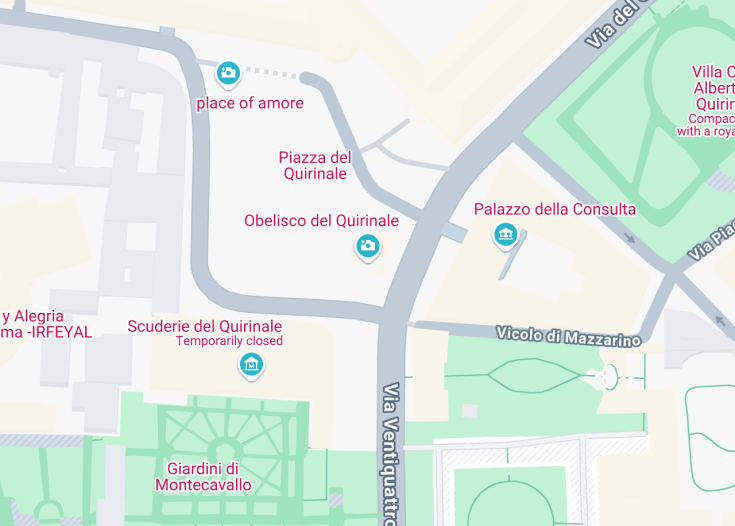The Obelisk at Piazza del Quirinale is a remarkable ancient monument situated in the heart of Rome, Italy. Standing at an impressive 14.63 meters, it not only captivates visitors with its historical significance but also enhances the beauty of the surrounding area, serving as a testament to Roman engineering and artistry.
Visitors should take the time to explore the surrounding gardens and the majestic architecture of the Quirinale Palace, which provides a stunning backdrop to the obelisk. A leisurely stroll around the piazza will reveal Rome’s rich cultural heritage.
For those planning to admire the obelisk, consider visiting during the early morning or late afternoon. These times offer softer lighting for photography while helping avoid the crowds, allowing for a more intimate experience with this magnificent ancient artifact.
Explore the Majestic Obelisk at Piazza del Quirinale
The Obelisk at Piazza del Quirinale stands as a testament to ancient Roman history, captivating visitors with its majestic presence in the heart of Rome, Italy. Erected in the late 18th century, this stunning monument measures a towering 14.63 meters tall, reaching an impressive height of 28.94 meters when including its base. Crafted from red granite in Egypt, this obelisk was brought to Rome likely during the reign of Emperor Domitian in the 1st century A.D. and was originally placed near the Mausoleum of Augustus.
The absence of inscriptions suggests a construction date that may not align with other ancient Egyptian obelisks found throughout the city. However, its transportation to Rome and eventual erection by Pope Pius VI in 1786 reflect the significance it holds as both a historical artifact and a cultural landmark. Surrounded by the delightful statues of the Dioscuri, the obelisk draws tourists looking to immerse themselves in Rome’s rich architectural narrative.
Activities and Attractions at the Quirinale Obelisk
Visitors to the Obelisk in Piazza del Quirinale are treated to more than just an impressive view of the monument itself. The surrounding area offers a variety of activities for tourists. You can enjoy leisurely strolls through beautiful gardens nearby, or capture the beauty of the obelisk framed by ornate architecture.
Take Photos
The combination of the obelisk and the stunning statues of the Dioscuri makes for breathtaking photographs, perfect for your travel album.
Explore Nearby Attractions
The Quirinale area is rich in history, with various palaces, museums, and art galleries inviting exploration. Don’t miss the opportunity to visit the nearby Quirinale Palace, the official residence of the President of Italy.
Interesting Fact About the Obelisk at Piazza del Quirinale
An intriguing fact about the Obelisk at Piazza del Quirinale is that it is one of the few ancient Roman obelisks not adorned with inscriptions. This peculiarity raises questions about its origins and purpose. Although it was likely constructed in Egypt, its exact history and the reason for its lack of inscriptions remain unclear, making it a fascinating topic for historians and curious travelers alike.
Explore the Magnificent Obelisk at Piazza del Quirinale in Rome, Italy
The Obelisk at Piazza del Quirinale is a stunning example of ancient Egyptian artistry, standing proudly as one of the city’s remarkable historical landmarks. This magnificent obelisk, made from red granite sourced from Assuan, rises to an impressive height of 14.63 meters, and when combined with its base, the total height reaches nearly 29 meters. Visitors can marvel at this architectural wonder while also enjoying its rich history that dates back to the Roman Empire, possibly around the time of Domitian.
As you approach the obelisk, you’ll notice its elegant design and the intricate details that reveal its ancient origins, yet lack hieroglyphics that would usually provide insights into its story. It was once located at the entrance to the Mausoleum of Augustus and was painstakingly relocated and erected in its current position in 1786 by architect Giovanni Antinori at the behest of Pope Pius VI.
This site is perfect for history enthusiasts, art lovers, and anyone curious about Rome’s storied past. It beautifully complements a broader tourist route, making it an ideal stop when exploring the surrounding areas, including the stunning Quirinal Palace and the nearby Church of San Carlo alle Quattro Fontane. As you take in the grandeur of the obelisk, you’ll also be able to appreciate its interaction with the statues of the Dioscuri, enhancing the overall experience.
For those looking to immerse themselves deeply in Roman history, particularly in the context of the numerous obelisks scattered throughout the city, a visit to the piazza offers a unique perspective. Consider bringing a guidebook or joining a guided tour for insights into the historical significance of each structure.
Tips: Arrive early in the morning or later in the afternoon to avoid crowds and enjoy a more peaceful experience. Don’t forget your camera—the shadows cast by the obelisk during sunset create picturesque views.
The Ideal Time to Visit the Obelisk at Piazza del Quirinale in Rome, Italy
The best times to visit the Obelisk at Piazza del Quirinale are during the spring and autumn months, specifically from March to June and September to November. During these periods, the weather is usually mild, making it great for strolling through the piazza and appreciating the obelisk in comfort.
Recurring Events and Opportunities
One prime event to consider visiting for is the Rome’s birthday celebrations on April 21. This festival showcases various historical reenactments and celebrations in the city, allowing the obelisk to play a central role amidst the vibrancy of the festivities.
Accessibility and Limitations
While the Obelisk at Piazza del Quirinale is accessible to most visitors, there are some limitations to be aware of.
Accessibility
Limitations
- High foot traffic, especially during peak tourist seasons.
- There are limited seating options nearby, so plan for standing or walking.
- Group tours may restrict individual exploration time.
Notes to visitors
- Photography is encouraged, but be respectful of others’ enjoyment of the site.
- Keep an eye on your belongings as it can be crowded.
General Information
Details for your visit to the Obelisk at Piazza del Quirinale
Location
The Obelisk is centrally located near several significant landmarks, like the Quirinal Palace and the Trevi Fountain, making it an essential part of any Rome itinerary.
Address:
P.za del Quirinale, 00187 Roma RM, ItalyVisitor Information
The Obelisk at Piazza del Quirinale can be visited freely as it is situated in a public area. For the most rewarding experience, visit during the early morning or late afternoon when the lighting enhances its beauty and fewer crowds allow for better photography opportunities.
How to Reach the Obelisk at Piazza del Quirinale
Getting to the Obelisk is convenient given its central location. Here are some transport options:
Car
The Obelisk can be conveniently accessed by car, though parking can be limited. Nearby parking structures may have fees.
| Route | Distance | Travel time |
|---|---|---|
| From Termini Station | 1.5 miles (2.4 km) | 10 minutes |
| From Vatican City | 2 miles (3.2 km) | 15 minutes |
| From Fiumicino Airport | 20 miles (32 km) | 40 minutes |
Public Transport
The closest metro station is Barberini on Line A, which is about a 10-minute walk from the obelisk. Buses with stops nearby also make it easily reachable from various parts of the city.
Nearby Attractions
- Quirinal Palace – 0.5 miles (0.8 km)
- Church of San Carlo alle Quattro Fontane – 0.6 miles (1 km)
- Trevi Fountain – 0.9 miles (1.5 km)
- Spanish Steps – 1 mile (1.6 km)
- Piazza Navona – 1.2 miles (1.9 km)
- Roman Forum – 1.3 miles (2.1 km)
- Colosseum – 1.5 miles (2.4 km)
- Pantheon – 1.5 miles (2.4 km)
- Campo de’ Fiori – 1.6 miles (2.5 km)
- Galleria Borghese – 1.7 miles (2.7 km)
- Vittoriano Monument – 1.8 miles (2.9 km)
- Palatine Hill – 1.9 miles (3 km)
Common Questions
What is the history of the Obelisk at Piazza del Quirinale?
The Obelisk at Piazza del Quirinale has a rich history that dates back to ancient Egypt. Crafted from red granite, it was likely erected during the 1st century AD, possibly under Emperor Domitian. Originally, this obelisk was situated at the entrance of the Mausoleum of Augustus, paired with a similar structure, known as the Esquilino Obelisk.
Remarkably, this obelisk lacks inscriptions, which suggests that it may not be as ancient as many of its counterparts. In 1527, it was rediscovered alongside the Esquilino and subsequently, in 1786, it was relocated to its current position in Piazza del Quirinale by Pope Pius VI, who commissioned its installation. The obelisk now stands adjacent to the statues of the Dioscuri, which were salvaged from the nearby Baths of Constantine. Its historical journey reflects Rome’s deep connections to its ancient past and its longstanding reverence for monuments that symbolize power and eternity.
What architectural style surrounds the Obelisk at Piazza del Quirinale?
The surroundings of the Obelisk at Piazza del Quirinale are characterized by a blend of Neoclassicism and Baroque architecture, reflecting the grandeur of the area. The obelisk is prominently positioned in a beautifully landscaped piazza, which enhances its monumental presence.
Architect Giovanni Antinori’s design for the obelisk’s base marries harmoniously with the elegant statues of the Dioscuri, lending a classical touch that evokes the power and mythology of ancient Rome. The Quirinale Palace, located nearby, showcases aspects of Renaissance and Baroque styles further enriching the visual context. Visitors can appreciate the intricate details, symmetry, and proportion typical of these architectural movements, all while marveling at the obelisk, which serves as a focal point for the entire square.
Are there any myths or legends associated with the Obelisk at Piazza del Quirinale?
Various legends and myths surround the obelisks of ancient Rome, including the one at Piazza del Quirinale. Many people believe that obelisks were built to honor the sun god Ra, serving as symbolic “sun rays” and representing divine authority.
In the context of the Quirinale obelisk, some stories suggest that its original placement near the Mausoleum of Augustus was meant to inspire awe and reverence for the emperor’s power. Furthermore, myths involving the Dioscuri, the twin horsemen Castor and Pollux represented by the statues that stand adjacent to the obelisk, add layers of Roman mythology to the site. Their role as protectors and guides is interwoven with the cultural significance of the obelisk itself, making this location a nexus of history, belief, and legend that dates back thousands of years.
What materials were used in the construction of the Obelisk at Piazza del Quirinale?
The Obelisk at Piazza del Quirinale is primarily constructed from red granite sourced from Aswan, Egypt. This durable and striking stone was widely utilized in ancient Egyptian architecture due to its ability to withstand the test of time and the elements.
This particular obelisk stands at an impressive height of 14.63 meters and, when including its base, reaches nearly 29 meters tall. The granite’s rich color and unique texture contribute to its visual appeal and historical gravitas. Additionally, the base of the obelisk, designed by Giovanni Antinori, integrates with artistic elements, including the statues of the Dioscuri. The combination of these materials not only enhances the monument’s aesthetic but also its significance as part of Rome’s ancient heritage, linking the present with the past through the longevity of its construction materials.
What is the significance of the Dioscuri statues near the Obelisk?
The Dioscuri statues, representing the twin brothers Castor and Pollux, are significant to the history and iconography surrounding the Obelisk at Piazza del Quirinale. In Roman mythology, the Dioscuri were regarded as divine protectors of horses and knights, symbolizing strength, loyalty, and heroism.
These statues enhance the visual impact of the piazza, emphasizing the connection between the obelisk and Roman traditions. Erected alongside the obelisk in 1786 when Pope Pius VI moved the structure, the Dioscuri add a layer of mythological meaning to the site. Furthermore, their presence reflects Rome’s tradition of integrating sacred and political symbols, underscoring the obelisk’s original function as a monument to imperial authority. Collectively, the obelisk and the Dioscuri narratives serve as a poignant reminder of Rome’s rich cultural legacy and its seamless blend of history and mythology.

Is the Obelisk at piazza del Quirinale in Rome worth visiting?
The Obelisk at Piazza del Quirinale is indeed worth a visit for anyone exploring Rome. This ancient structure stands tall at 14.63 meters, and when paired with its base, towers at 28.94 meters, offering a striking sight amidst the historic surroundings.
Originally built in Egypt, the obelisk reflects the grandeur of ancient architectural prowess and serves as a reminder of Rome’s rich history, including its connection to the Mausoleo di Augusto.
Its relocation to the Quirinal Palace area and the stunning nearby statues of the Dioscuri create an impressive backdrop, making it a perfect spot for tourists and photography enthusiasts alike. Don’t miss this historical gem during your Roman adventure!









